child restraint Seat Alhambra 2009 Owner's Manual
[x] Cancel search | Manufacturer: SEAT, Model Year: 2009, Model line: Alhambra, Model: Seat Alhambra 2009Pages: 285, PDF Size: 7.62 MB
Page 5 of 285
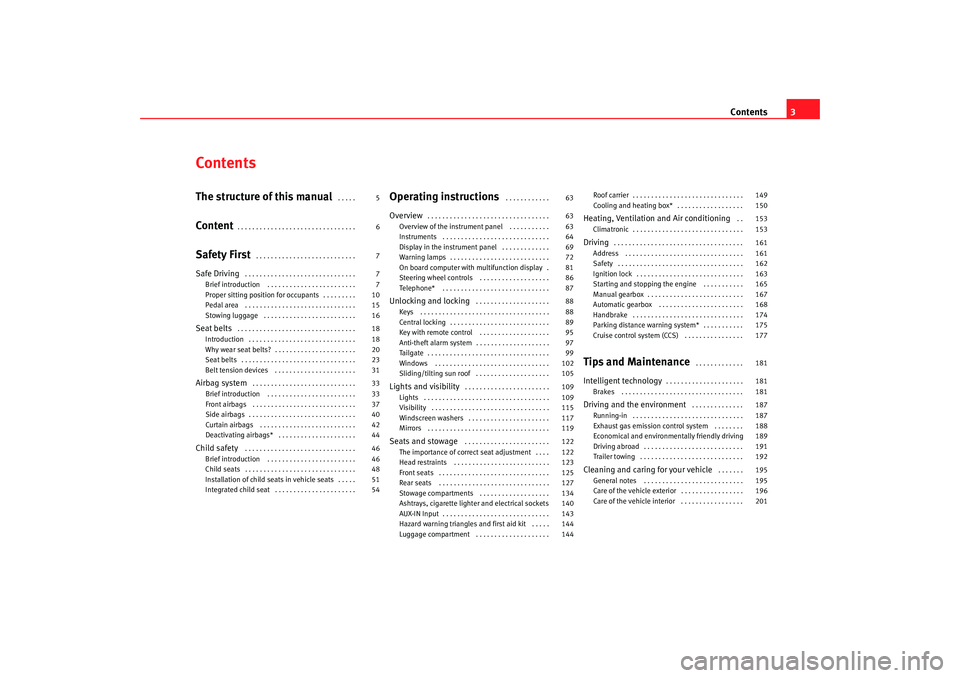
Contents3
ContentsThe structure of this manual
. . . . .
Content
. . . . . . . . . . . . . . . . . . . . . . . . . . . . . . . .
Safety First
. . . . . . . . . . . . . . . . . . . . . . . . . . .
Safe Driving
. . . . . . . . . . . . . . . . . . . . . . . . . . . . . .
Brief introduction . . . . . . . . . . . . . . . . . . . . . . . .
Proper sitting position for occupants . . . . . . . . .
Pedal area . . . . . . . . . . . . . . . . . . . . . . . . . . . . . .
Stowing luggage . . . . . . . . . . . . . . . . . . . . . . . . .
Seat belts
. . . . . . . . . . . . . . . . . . . . . . . . . . . . . . . .
Introduction . . . . . . . . . . . . . . . . . . . . . . . . . . . . .
Why wear seat belts? . . . . . . . . . . . . . . . . . . . . . .
Seat belts . . . . . . . . . . . . . . . . . . . . . . . . . . . . . . .
Belt tension devices . . . . . . . . . . . . . . . . . . . . . .
Airbag system
. . . . . . . . . . . . . . . . . . . . . . . . . . . .
Brief introduction . . . . . . . . . . . . . . . . . . . . . . . .
Front airbags . . . . . . . . . . . . . . . . . . . . . . . . . . . .
Side airbags . . . . . . . . . . . . . . . . . . . . . . . . . . . . .
Curtain airbags . . . . . . . . . . . . . . . . . . . . . . . . . .
Deactivating airbags* . . . . . . . . . . . . . . . . . . . . .
Child safety
. . . . . . . . . . . . . . . . . . . . . . . . . . . . . .
Brief introduction . . . . . . . . . . . . . . . . . . . . . . . .
Child seats . . . . . . . . . . . . . . . . . . . . . . . . . . . . . .
Installation of child seats in vehicle seats . . . . .
Integrated child seat . . . . . . . . . . . . . . . . . . . . . .
Operating instructions
. . . . . . . . . . . .
Overview
. . . . . . . . . . . . . . . . . . . . . . . . . . . . . . . . .
Overview of the instrument panel . . . . . . . . . . .
Instruments . . . . . . . . . . . . . . . . . . . . . . . . . . . . .
Display in the instrument panel . . . . . . . . . . . . .
Warning lamps . . . . . . . . . . . . . . . . . . . . . . . . . . .
On board computer with multifunction display .
Steering wheel controls . . . . . . . . . . . . . . . . . . .
Telephone* . . . . . . . . . . . . . . . . . . . . . . . . . . . . .
Unlocking and locking
. . . . . . . . . . . . . . . . . . . .
Keys . . . . . . . . . . . . . . . . . . . . . . . . . . . . . . . . . . .
Central locking . . . . . . . . . . . . . . . . . . . . . . . . . . .
Key with remote control . . . . . . . . . . . . . . . . . . .
Anti-theft alarm system . . . . . . . . . . . . . . . . . . . .
Tailgate . . . . . . . . . . . . . . . . . . . . . . . . . . . . . . . . .
Windows . . . . . . . . . . . . . . . . . . . . . . . . . . . . . . .
Sliding/tilting sun roof . . . . . . . . . . . . . . . . . . . .
Lights and visibility
. . . . . . . . . . . . . . . . . . . . . . .
Lights . . . . . . . . . . . . . . . . . . . . . . . . . . . . . . . . . .
Visibility . . . . . . . . . . . . . . . . . . . . . . . . . . . . . . . .
Windscreen washers . . . . . . . . . . . . . . . . . . . . . .
Mirrors . . . . . . . . . . . . . . . . . . . . . . . . . . . . . . . . .
Seats and stowage
. . . . . . . . . . . . . . . . . . . . . . .
The importance of correct seat adjustment . . . .
Head restraints . . . . . . . . . . . . . . . . . . . . . . . . . .
Front seats . . . . . . . . . . . . . . . . . . . . . . . . . . . . . .
Rear seats . . . . . . . . . . . . . . . . . . . . . . . . . . . . . .
Stowage compartments . . . . . . . . . . . . . . . . . . .
Ashtrays, cigarette lighter and electrical sockets
AUX-IN Input . . . . . . . . . . . . . . . . . . . . . . . . . . . . .
Hazard warning triangles and first aid kit . . . . .
Luggage compartment . . . . . . . . . . . . . . . . . . . . Roof carrier . . . . . . . . . . . . . . . . . . . . . . . . . . . . . .
Cooling and heating box* . . . . . . . . . . . . . . . . . .
Heating, Ventilation and Air conditioning
. .
Climatronic . . . . . . . . . . . . . . . . . . . . . . . . . . . . . .
Driving
. . . . . . . . . . . . . . . . . . . . . . . . . . . . . . . . . . .
Address . . . . . . . . . . . . . . . . . . . . . . . . . . . . . . . .
Safety . . . . . . . . . . . . . . . . . . . . . . . . . . . . . . . . . .
Ignition lock . . . . . . . . . . . . . . . . . . . . . . . . . . . . .
Starting and stopping the engine . . . . . . . . . . .
Manual gearbox . . . . . . . . . . . . . . . . . . . . . . . . . .
Automatic gearbox . . . . . . . . . . . . . . . . . . . . . . .
Handbrake . . . . . . . . . . . . . . . . . . . . . . . . . . . . . .
Parking distance warning system* . . . . . . . . . . .
Cruise control system (CCS) . . . . . . . . . . . . . . . .
Tips and Maintenance
. . . . . . . . . . . . .
Intelligent technology
. . . . . . . . . . . . . . . . . . . . .
Brakes . . . . . . . . . . . . . . . . . . . . . . . . . . . . . . . . .
Driving and the environment
. . . . . . . . . . . . . .
Running-in . . . . . . . . . . . . . . . . . . . . . . . . . . . . . .
Exhaust gas emission control system . . . . . . . .
Economical and environmentally friendly driving
Driving abroad . . . . . . . . . . . . . . . . . . . . . . . . . . .
Trailer towing . . . . . . . . . . . . . . . . . . . . . . . . . . . .
Cleaning and caring for your vehicle
. . . . . . .
General notes . . . . . . . . . . . . . . . . . . . . . . . . . . .
Care of the vehicle exterior . . . . . . . . . . . . . . . . .
Care of the vehicle interior . . . . . . . . . . . . . . . . .
5
6
7
7
7
10
15
16
18
18
20
23
31
33
33
37
40
42
44
46
46
48
51
54 63
63
63
64
69
72
81
86
87
88
88
89
95
97
99
102
105
109
109
115
117
119
122
122
123
125
127
134
140
143
144
144 149
150
153
153
161
161
162
163
165
167
168
174
175
177
181
181
181
187
187
188
189
191
192
195
195
196
201
alhambra_aleman.book Seite 3 Montag, 23. M‰
rz 2009 1:12 13
Page 9 of 285

Safe Driving7
Safety First
Operating instructions
Tips and Maintenance
Te c h n i c a l D a t a
Safety FirstSafe DrivingBrief introductionDear SEAT Driver
Safety first!This chapter contains important information, tips, suggestions and
wa rn in gs tha t y ou sh ould read a n d follow in the i nterest of yo ur own
safety and the safety of your passengers.
WARNING
•
This manual contains important information concerning the driver's
and passengers' handling of the vehicle. The other booklets in the vehicle
wallet also contain further information that you should be aware of for your
own safety and for the safety of your passengers.
•
Ensure that the onboard documentation is kept in the vehicle at all
times. This is especially important when lending or selling the vehicle to
another person.
Safety equipment
The safety equipment is a part of the occupant protection
system and can reduce the risk of injury during an accident.Never “gamble” with your safety and the safety of your passengers. In the
event of an accident, the safety equipment could reduce the risk of injury. The
following list includes most of the safety equipment in your SEAT:•
optimised three-point seat belts for all seats,
•
seat belt tension devices for driver and passenger,
•
Belt height adjustment for the front seats and outer seats in the second
row,
•
frontal airbags for driver and passenger,
•
side airbags for driver and passenger,
•
curtain airbags,
•
ISOFIX anchorage for ISOFIX child seats in the outside seats in the second
and third rows,
•
Height-adjustable head restraints and
•
adjustable steering column.
The safety equipment mentioned above works together to provide you and
your passengers with the best possible protection in accident situations. But
this safety equipment cannot help you or your passengers if you or your
passengers assume an incorrect sitting position or do not properly adjust or
use this equipment.
alhambra_aleman.book Seite 7 Montag, 23. M‰ rz 2009 1:12 13
Page 10 of 285
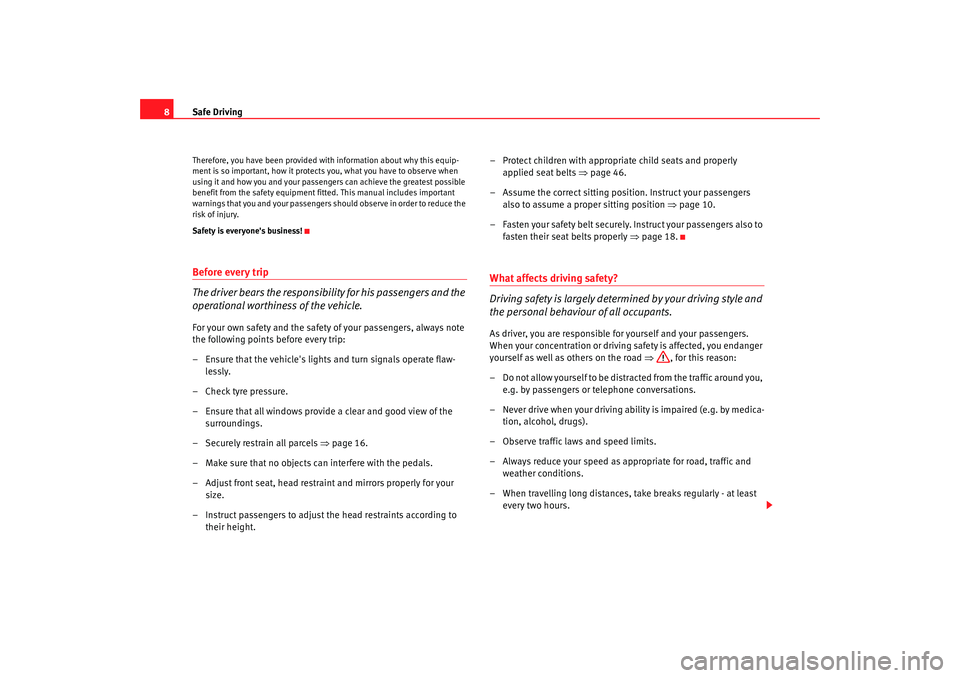
Safe Driving
8Therefore, you have been provided with information about why this equip-
ment is so important, how it protects you, what you have to observe when
using it and how you and your passengers can achieve the greatest possible
benefit from the safety equipment fitted. This manual includes important
warnings that you and your passengers should observe in order to reduce the
risk of injury.
Safety is everyone's business!Before every trip
The driver bears the responsibility for his passengers and the
operational worthiness of the vehicle.For your own safety and the safety of your passengers, always note
the following points before every trip:
– Ensure that the vehicle's lights and turn signals operate flaw-
lessly.
– Check tyre pressure.
– Ensure that all windows provide a clear and good view of the surroundings.
– Securely restrain all parcels ⇒page 16.
– Make sure that no objects can interfere with the pedals.
– Adjust front seat, head restraint and mirrors properly for your size.
– Instruct passengers to adjust the head restraints according to their height. – Protect children with appropriate child seats and properly
applied seat belts ⇒page 46.
– Assume the correct sitting position. Instruct your passengers also to assume a proper sitting position ⇒page 10.
– Fasten your safety belt securely. Instruct your passengers also to fasten their seat belts properly ⇒page 18.
What affects driving safety?
Driving safety is largely determined by your driving style and
the personal behaviour of all occupants.As driver, you are responsible for yourself and your passengers.
When your concentration or driving safety is affected, you endanger
yourself as well as others on the road ⇒, for this reason:
– Do not allow yourself to be distracted from the traffic around you, e.g. by passengers or telephone conversations.
– Never drive when your driving ability is impaired (e.g. by medica- tion, alcohol, drugs).
– Observe traffic laws and speed limits.
– Always reduce your speed as appropriate for road, traffic and weather conditions.
– When travelling long distances, take breaks regularly - at least every two hours.
alhambra_aleman.book Seite 8 Montag, 23. M‰ rz 2009 1:12 13
Page 15 of 285

Safe Driving13
Safety First
Operating instructions
Tips and Maintenance
Te c h n i c a l D a t a
– Adjust the head restraint so that its upper edge is at the same
level as the top of your head.
– Keep both feet in the footwell in front of the individual seat.
– Fasten your safety belt securely.
– Use an appropriate child restraint system when you take children in the vehicle.
WARNING
If the passengers on the individual seats are not sitting properly, they
could sustain severe injuries.•
Adjust the head restraint properly to achieve maximum protection.
•
The seat belts can only provide optimal protection when the backrests
are properly engaged in the upright position and the passengers are
wearing their seat belts properly. If passengers on the individual seats are
not sitting in an upright position, the risk of injury due to incorrect posi-
tioning of the belt web increases.
Correct sitting position for passengers in the rear seats
Passengers in the rear seats must sit up straight, keep their
feet in the foot well s and wear their seat belts properly.To reduce the risk of injury in the event of a sudden braking
manoeuvre or an accident, passengers on the rear bench seat must
observe the following:
– Adjust the headrest to the correct position. – Keep both feet in the foot well in front of the rear seat.
– Fasten your seat belt correctly
⇒page 18.
– Use an appropriate child restraint system when you take children in the vehicle ⇒ page 46.
WARNING
•
If the passengers on the rear seat are not sitting properly, they could
sustain severe injuries.
•
Adjust the head restraint properly to achieve maximum protection.
•
Seat belts can only provide optimal protection when backrests are in an
upright position and the passengers are wearing their seat belts properly.
If passengers on the rear seat are not sitting in an upright position, the risk
of injury due to incorrect positioning of the belt web increases.
alhambra_aleman.book Seite 13 Montag, 23. M‰ rz 2009 1:12 13
Page 16 of 285
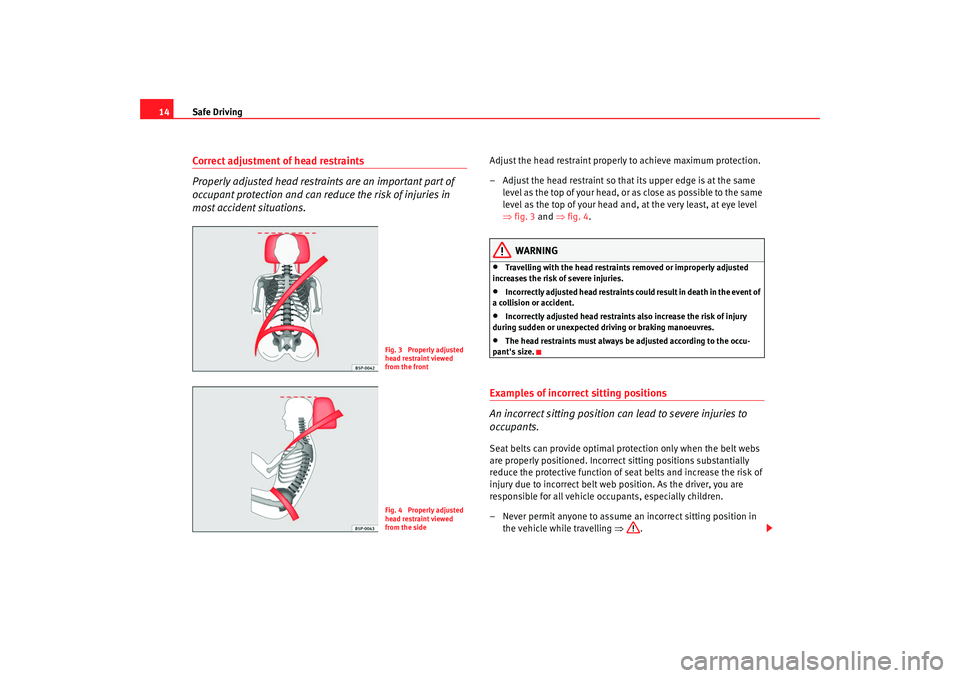
Safe Driving
14Correct adjustment of head restraints
Properly adjusted head restrain ts are an important part of
occupant protection and can reduce the risk of injuries in
most accident situations.
Adjust the head restraint properly to achieve maximum protection.
– Adjust the head restraint so that its upper edge is at the same
level as the top of your head, or as close as possible to the same
level as the top of your head and, at the very least, at eye level
⇒fig. 3 and ⇒fig. 4 .
WARNING
•
Travelling with the head restraints removed or improperly adjusted
increases the risk of severe injuries.
•
Incorrectly adjusted head restraints could result in death in the event of
a collision or accident.
•
Incorrectly adjusted head restraints also increase the risk of injury
during sudden or unexpected driving or braking manoeuvres.
•
The head restraints must always be adjusted according to the occu-
pant's size.
Examples of incorrect sitting positions
An incorrect sitting position can lead to severe injuries to
occupants.Seat belts can provide optimal protection only when the belt webs
are properly positioned. Incorrect sitting positions substantially
reduce the protective function of seat belts and increase the risk of
injury due to incorrect belt web position. As the driver, you are
responsible for all vehicle occupants, especially children.
– Never permit anyone to assume an incorrect sitting position in the vehicle while travelling ⇒.
Fig. 3 Properly adjusted
head restraint viewed
from the frontFig. 4 Properly adjusted
head restraint viewed
from the side
alhambra_aleman.book Seite 14 Montag, 23. M‰ rz 2009 1:12 13
Page 20 of 285
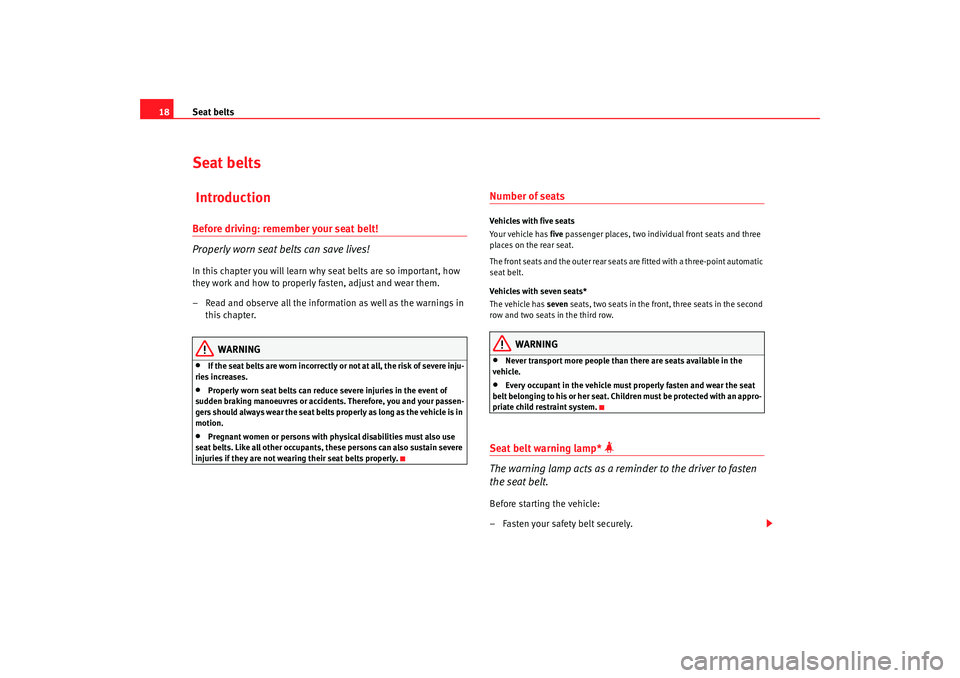
Seat belts
18Seat belts IntroductionBefore driving: remember your seat belt!
Properly worn seat belts can save lives!In this chapter you will learn why seat belts are so important, how
they work and how to properly fasten, adjust and wear them.
– Read and observe all the information as well as the warnings in
this chapter.
WARNING
•
If the seat belts are worn incorrectly or not at all, the risk of severe inju-
ries increases.
•
Properly worn seat belts can reduce severe injuries in the event of
sudden braking manoeuvres or accidents. Therefore, you and your passen-
gers should always wear the seat belts properly as long as the vehicle is in
motion.
•
Pregnant women or persons with physical disabilities must also use
seat belts. Like all other occupants, these persons can also sustain severe
injuries if they are not wearing their seat belts properly.
Number of seatsVehicles with five seats
Yo u r ve h i c l e ha s five passenger places, two individual front seats and three
places on the rear seat.
The front seats and the outer rear seats are fitted with a three-point automatic
seat belt.
Vehicles with seven seats*
The vehicle has seven seats, two seats in the front, three seats in the second
row and two seats in the third row.
WARNING
•
Never transport more people than there are seats available in the
vehicle.
•
Every occupant in the vehicle must properly fasten and wear the seat
belt belonging to his or her seat. Chil dren must be protected with an appro-
priate child restraint system.
Seat belt warning lamp*
The warning lamp acts as a reminder to the driver to fasten
the seat belt.Before starting the vehicle:
– Fasten your safety belt securely.
alhambra_aleman.book Seite 18 Montag, 23. M‰ rz 2009 1:12 13
Page 28 of 285
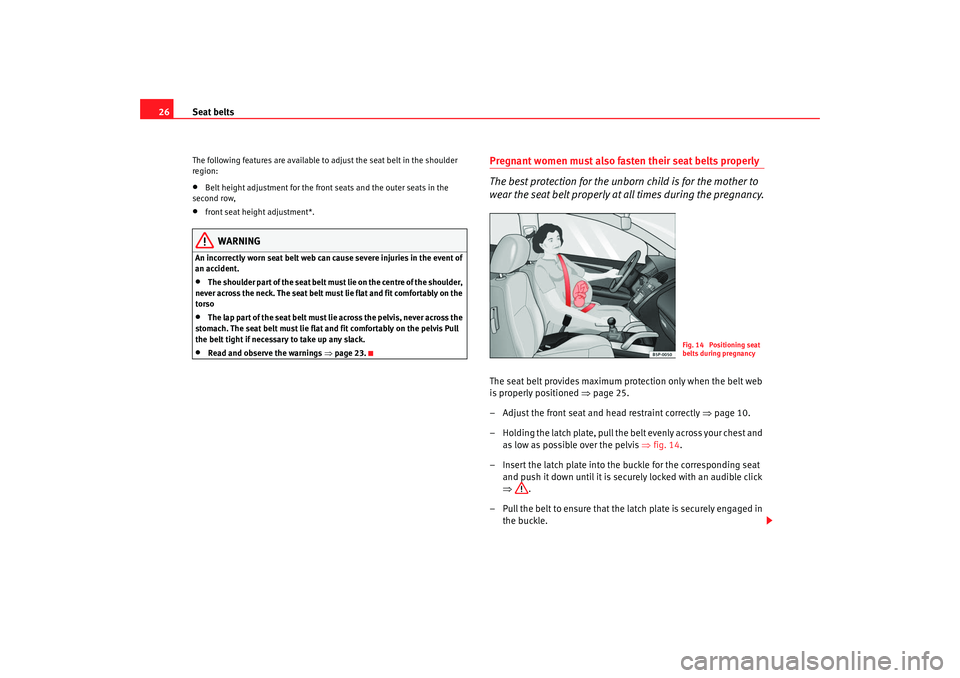
Seat belts
26The following features are available to adjust the seat belt in the shoulder
region:•
Belt height adjustment for the front seats and the outer seats in the
second row,
•
front seat height adjustment*.
WARNING
An incorrectly worn seat belt web can cause severe injuries in the event of
an accident.•
T h e s h o u l d e r p a r t o f t h e s e a t b e l t m u st l i e o n t h e ce n t r e o f t h e s h o u l d e r ,
never across the neck. The seat belt must lie flat and fit comfortably on the
torso
•
The lap part of the seat belt must lie across the pelvis, never across the
stomach. The seat belt must lie flat and fit comfortably on the pelvis Pull
the belt tight if necessary to take up any slack.
•
Read and observe the warnings ⇒page 23.
Pregnant women must also fasten their seat belts properly
The best protection for the unborn child is for the mother to
wear the seat belt properly at all times during the pregnancy.The seat belt provides maximum protection only when the belt web
is properly positioned ⇒page 25.
– Adjust the front seat and head restraint correctly ⇒page 10.
– Holding the latch plate, pull the belt evenly across your chest and as low as possible over the pelvis ⇒fig. 14 .
– Insert the latch plate into the buckle for the corresponding seat and push it down until it is securely locked with an audible click
⇒ .
– Pull the belt to ensure that the latch plate is securely engaged in the buckle.
Fig. 14 Positioning seat
belts during pregnancy
alhambra_aleman.book Seite 26 Montag, 23. M‰ rz 2009 1:12 13
Page 35 of 285
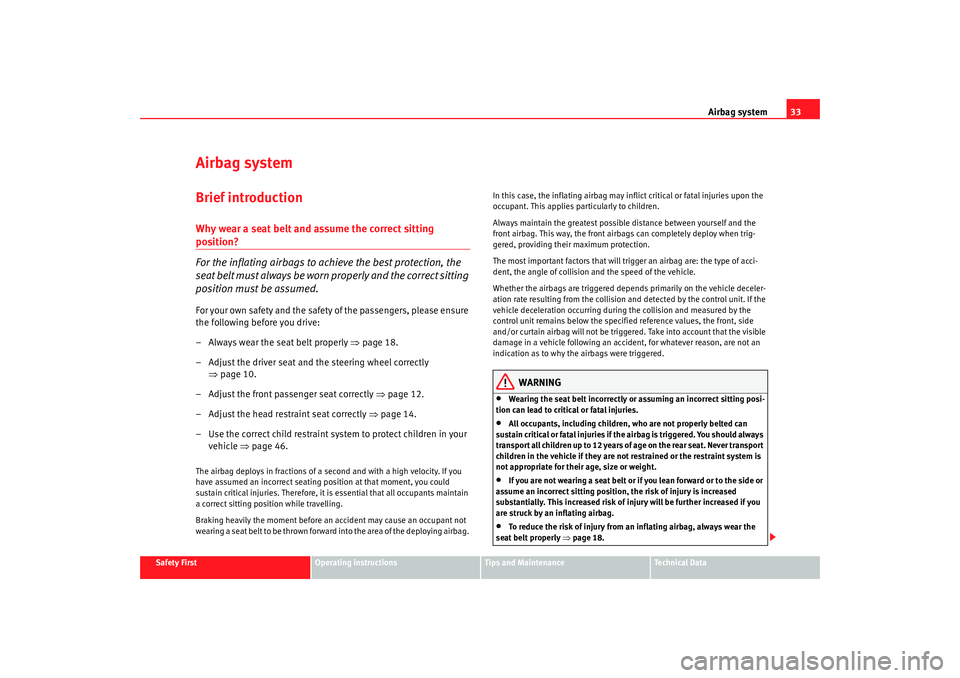
Airbag system33
Safety First
Operating instructions
Tips and Maintenance
Te c h n i c a l D a t a
Airbag systemBrief introductionWhy wear a seat belt and assume the correct sitting position?
For the inflating airbags to achieve the best protection, the
seat belt must always be worn properly and the correct sitting
position must be assumed.For your own safety and the safety of the passengers, please ensure
the following before you drive:
– Always wear the seat belt properly ⇒page 18.
– Adjust the driver seat and the steering wheel correctly ⇒page 10.
– Adjust the front passenger seat correctly ⇒page 12.
– Adjust the head restraint seat correctly ⇒page 14.
– Use the correct child restraint system to protect children in your vehicle ⇒page 46.The airbag deploys in fractions of a second and with a high velocity. If you
have assumed an incorrect seating position at that moment, you could
sustain critical injuries. Therefore, it is essential that all occupants maintain
a correct sitting position while travelling.
Braking heavily the moment before an accident may cause an occupant not
wearing a seat belt to be thrown forward into the area of the deploying airbag. In this case, the inflating airbag may inflict critical or fatal injuries upon the
occupant. This applies particularly to children.
Always maintain the greatest possible distance between yourself and the
front airbag. This way, the front airbags can completely deploy when trig-
gered, providing their maximum protection.
The most important factors that will trigger an airbag are: the type of acci-
dent, the angle of collision and the speed of the vehicle.
Whether the airbags are triggered depends primarily on the vehicle deceler-
ation rate resulting from the collision and detected by the control unit. If the
vehicle deceleration occurring during the collision and measured by the
control unit remains below the specified reference values, the front, side
and/or curtain airbag will not be triggered. Take into account that the visible
damage in a vehicle following an accident, for whatever reason, are not an
indication as to why the airbags were triggered.
WARNING
•
Wearing the seat belt incorrectly or assuming an incorrect sitting posi-
tion can lead to critical or fatal injuries.
•
All occupants, including children, who are not properly belted can
sustain critical or fatal injuries if the airbag is triggered. You should always
transport all children up to 12 years of age on the rear seat. Never transport
children in the vehicle if they are not restrained or the restraint system is
not appropriate for their age, size or weight.
•
If you are not wearing a seat belt or if you lean forward or to the side or
assume an incorrect sitting position, the risk of injury is increased
substantially. This increased risk of injury will be further increased if you
are struck by an inflating airbag.
•
To reduce the risk of injury from an inflating airbag, always wear the
seat belt properly ⇒page 18.
alhambra_aleman.book Seite 33 Montag, 23. M‰ rz 2009 1:12 13
Page 41 of 285

Airbag system39
Safety First
Operating instructions
Tips and Maintenance
Te c h n i c a l D a t a
In order to provide the desired extra protection in an accident, the airbags
have to deploy extremely rapidly (within fractions of a second). A fine dust
may develop when the airbag deploys. This is normal and is no indication
that there was a fire in the vehicle.
The function of the airbag covers if the airbags are triggeredThe airbag covers fold out of the steering wheel or dash panel when the driver
and front passenger airbags deploy. The airbag covers remain connected to
the steering wheel or the dash panel.Safety notes on front airbag system
If you use airbags correctly, they can considerably reduce the
risk of injury in many kinds of accident.When the front airbags are triggered they fill the zones marked in red (radius
of action). Therefore additional accessories should never be placed in these
areas
⇒,
The airbag covers fold out of the steering wheel or dash panel when the driver
and front passenger airbags deploy. The airbag covers remain connected to
the steering wheel or the dash panel.
WARNING
•
It is important that the driver keeps at a minimum of 25 cm from the
steering wheel It is important that the passenger moves the seat back as
far as possible, to keep a safe distance away from the instrument panel.
Failure to respect the minimum distance means that the airbag will not
protect you. Risk of fatal injury. In addition, the front seats and head restraints must always be positioned correctly for the height of the occu-
pant.
•
If you are not wearing a seat belt or if you lean forward or to the side or
assume an incorrect sitting position, the risk of injury is increased
substantially. This increased risk of injury will be further increased if you
are struck by an inflating airbag.
•
Never let a child travel on the front seat without an appropriate restraint
system. If the airbag is triggered in an accident, children can sustain
serious or fatal injuries from the airbag as it inflates ⇒page 46.
•
Occupants sitting in the front of the vehicle must never carry any
objects or pets in the deployment space between them and the airbags, or
allow children or other passengers to travel in this position.
•
The airbags provide protection for one accident only, if they have been
deployed they must be replaced.
•
It is also important not to attach any objects such as cup holders or
telephone mountings to the surfaces covering the airbag units.
•
Nothing should be placed on the windscreen area above the passenger
side airbag, for example notebooks or telephone holders. If the airbag is
activated, these objects may fly uncontrollably around the vehicle interior
and could cause injury.
•
Do not attempt to modify components of the airbag system in any
way.WARNING (continued)
alhambra_aleman.book Seite 39 Montag, 23. M‰ rz 2009 1:12 13
Page 48 of 285
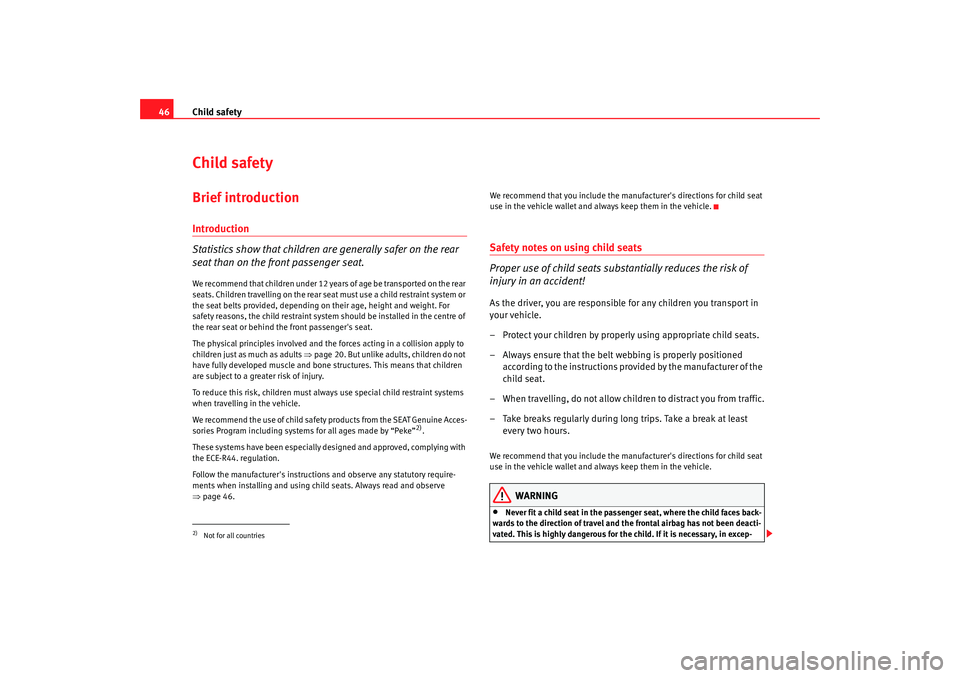
Child safety
46Child safetyBrief introductionIntroduction
Statistics show that children are generally safer on the rear
seat than on the front passenger seat.We recommend that children under 12 years of age be transported on the rear
seats. Children travelling on the rear seat must use a child restraint system or
the seat belts provided, depending on their age, height and weight. For
safety reasons, the child restraint system should be installed in the centre of
the rear seat or behind the front passenger's seat.
The physical principles involved and the forces acting in a collision apply to
children just as much as adults ⇒page 20. But unlike adults, children do not
have fully developed muscle and bone structures. This means that children
are subject to a greater risk of injury.
To reduce this risk, children must always use special child restraint systems
when travelling in the vehicle.
We recommend the use of child safety products from the SEAT Genuine Acces-
sories Program including systems for all ages made by “Peke”
2).
These systems have been especially designed and approved, complying with
the ECE-R44. regulation.
Follow the manufacturer's instructions and observe any statutory require-
ments when installing and using child seats. Always read and observe
⇒ page 46. We recommend that you include the manufacturer's directions for child seat
use in the vehicle wallet and always keep them in the vehicle.
Safety notes on using child seats
Proper use of child seats subs
tantially reduces the risk of
injury in an accident!As the driver, you are responsible for any children you transport in
your vehicle.
– Protect your children by properly using appropriate child seats.
– Always ensure that the belt webbing is properly positioned
according to the instructions provided by the manufacturer of the
child seat.
– When travelling, do not allow children to distract you from traffic.
– Take breaks regularly during long trips. Take a break at least every two hours.We recommend that you include the manufacturer's directions for child seat
use in the vehicle wallet and always keep them in the vehicle.
WARNING
•
Never fit a child seat in the passenger seat, where the child faces back-
wards to the direction of travel and the frontal airbag has not been deacti-
vated. This is highly dangerous for the child. If it is necessary, in excep-
2)Not for all countries
alhambra_aleman.book Seite 46 Montag, 23. M‰ rz 2009 1:12 13